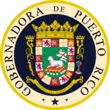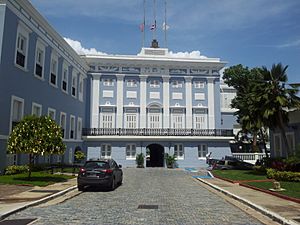Governor of Puerto Rico facts for kids
Quick facts for kids Governor of Puerto Rico |
|
|---|---|

Standard of the governor
|
|

Seal of the governor
|
|
| Executive branch of the government of Puerto Rico Office of the Governor of Puerto Rico |
|
| Style | His/Her Excellency (diplomatic) Governor (when presiding) First Executive (third person) |
| Residence | La Fortaleza |
| Term length | Four years, no term limit |
| Inaugural holder | Juan Ponce de León (Spanish colonial government) Luis Muñoz Marín (Constitution of the Commonwealth of Puerto Rico) |
| Formation | 1508 (Spanish colonial government) 1952 (Constitution of the Commonwealth of Puerto Rico) |
| Succession | Line of succession |
| Salary | US$70,000 (2013) |
The governor of Puerto Rico (Spanish: gobernador de Puerto Rico) is the main leader of the government in Puerto Rico. Puerto Rico is a special territory of the United States. The governor is chosen by the people of Puerto Rico in an election. They serve for four years and can be re-elected many times.
The governor is in charge of the executive branch of the government. This means they lead the part of the government that carries out laws. They are also the top commander of the Puerto Rico National Guard. As of January 2, 2025, Jenniffer González-Colón is the 190th governor of Puerto Rico.
The governor's job is to make sure local laws are followed. They can call meetings of the Legislative Assembly. They can also approve or reject new laws passed by the Assembly. The governor appoints people to government jobs and chooses judges. They can also grant pardons, which means forgiving someone for a crime. Since 1948, the people of Puerto Rico have elected their governor. Before that, the king of Spain or the president of the United States chose the governor.
Contents
History of Puerto Rico's Governors
The first known leaders in Puerto Rico were the caciques. These were the chiefs of the native Taínos people. They lived on the island before the Spanish arrived. It is thought that the cacique was chosen by the people. Their importance depended on the size of their tribe. The Taínos were mostly peaceful. Agüeybaná I was a well-known cacique when the Spanish came in 1493.
Spanish Rule and Early Leaders
When the Spanish Empire took over Puerto Rico in the 1500s, Juan Ponce de León became the island's first governor. He was a Spanish explorer. Another person, Vicente Yáñez Pinzón, was supposed to be the leader before him. But he never actually took the job.
The Spanish king chose who would be the governor of Puerto Rico. The governor was responsible for the island's growth and wealth. They also had to report back to the government in Spain. The first Puerto Rican to be an interim governor was Juan Ponce de León II. He was the grandson of the explorer and served in 1579. After 1580, Puerto Rico's government became a "Captaincy General." Governors then also held the title of Captain General.
Under United States Control
On July 25, 1898, during the Spanish–American War, the United States took over Puerto Rico. After the war, Spain gave Puerto Rico to the United States. This was part of the 1898 Treaty of Paris. At first, the United States military ruled Puerto Rico. The US president appointed the governor and other officials.
In 1900, a US law called the Foraker Act was passed. This law created a civilian government in Puerto Rico. The president still appointed the governor and an executive council. But there was also a House of Representatives with elected members. Charles Herbert Allen was the first civilian governor under this new system. This system continued until 1948.
In 1947, President Harry S. Truman approved a law allowing Puerto Ricans to elect their own governor. Since 1948, the governor has been chosen by the people every four years. Luis Muñoz Marín became the first governor elected by the people.
The current government structure was set up in 1952. This happened when the Constitution of the Commonwealth of Puerto Rico was approved. Luis Muñoz Marín was re-elected as the first governor under this new Constitution. The governor is still elected by the people every four years. They lead the executive branch of the Commonwealth. The new governor takes office on January 2 of the year after their election.
In June 2025, a new law was proposed. It suggested that if the governor resigns, dies, or is removed, the President of the Senate would become governor. This would happen if there was no confirmed Secretary of State.
Governor's Responsibilities and Powers
The governor is the leader of the government of Puerto Rico. They can reject laws passed by the Puerto Rican legislature. The governor also chooses the members of their cabinet. These choices must be approved by the Legislature. The governor also appoints judges to the Supreme Court and other courts.
Each year, the governor gives two important speeches to the legislature. One is about the "State of the Commonwealth." The other speech presents the "Recommended Budget" for the next year. The governor is also the top commander of the Puerto Rico National Guard. They also act as the chief diplomat for Puerto Rico.

Who Can Be Governor?
The Constitution of Puerto Rico was put into effect on July 25, 1952. To be governor, a person must be a citizen of the United States. They must also have lived in Puerto Rico for five years in a row before the election. Finally, they must be at least 35 years old when they are elected.
A governor serves for four years. Their term starts on January 2 after their election. There is no limit to how many times a governor can serve. Luis Muñoz Marín, the first elected governor, served four terms from 1949 to 1965. Most governors since then have served one or two terms. Rafael Hernández Colón served three terms, but not all in a row. He served from 1973 to 1977, and then again from 1985 to 1993.
How Governors Are Elected
The people of Puerto Rico vote directly for their governor. Candidates usually belong to a political party. So far, every elected governor has been from either the New Progressive Party of Puerto Rico or the Popular Democratic Party of Puerto Rico. To win, a candidate needs to get more votes than any other candidate. They do not need to get more than half of all the votes.
If a candidate wins by less than 0.5% of the votes, the law says all the votes must be counted again. This has only happened twice in gubernatorial elections. It occurred in 1980 and 2004.
Who Takes Over if the Governor Leaves Office?
If a governor dies, resigns, or is removed from office, the Secretary of State becomes governor. They serve until the end of the four-year term. If the Secretary of State cannot take the job, then the Secretary of Justice becomes governor. After that, there is a list of other cabinet members who would take over. This list includes the Secretary of Treasury, Secretary of Education, and others. If none of these people are available, the Legislative Assembly chooses a new governor.
Sometimes, the governor is away from Puerto Rico for a short time. In this case, the Secretary of State becomes the acting governor. If the Secretary of State is also away, the next person on the list of cabinet members takes over. This happens more often now because travel is easier.
The 2019 Leadership Change
On July 24, 2019, Governor Ricardo Rosselló announced he would resign. This happened after two weeks of protests in Puerto Rico. He was the first elected governor to resign. His resignation became official on August 2, 2019. Before leaving, Rosselló nominated Pedro Pierluisi to be Secretary of State. He hoped Pierluisi would become his successor. However, the legislature did not fully approve Pierluisi's nomination before Rosselló resigned.
Even without full approval, Pierluisi was sworn in as governor. This led to a legal challenge. Less than a week later, the Supreme Court of Puerto Rico ruled that Pierluisi had taken office incorrectly. They removed him from office on August 7. At that time, the next person in line was the Secretary of Justice, Wanda Vázquez Garced. She then became governor, following the original line of succession.
See also
 In Spanish: Gobernador de Puerto Rico para niños
In Spanish: Gobernador de Puerto Rico para niños


